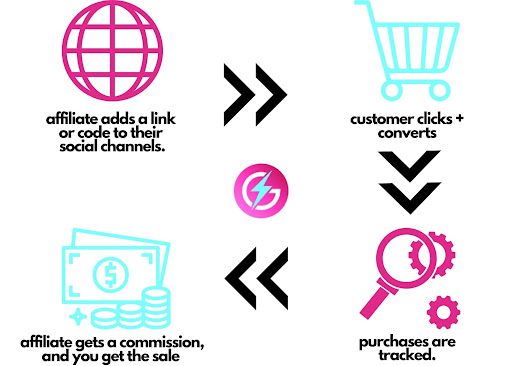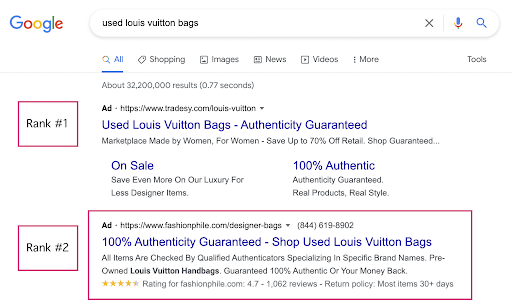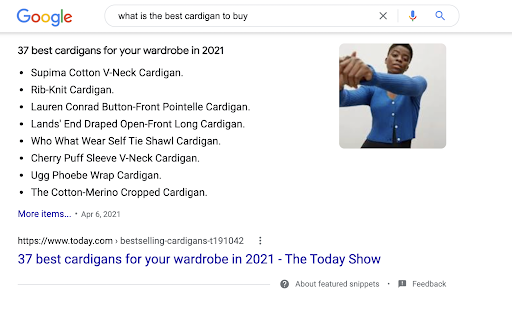How to Work with Fashion Affiliates to Boost Your SEO

Affiliates and SEO: the complementary colors of the marketing industry.
Affiliate marketing is an effective strategy to market a product or service at a low budget, with little effort and time, at low risk while guaranteeing a high return on investment (ROI), increased brand awareness, and growth.
SEO increases your website’s visibility on search engines leading to more organic traffic and conversion opportunities. When combined, SEO and affiliate marketing are a powerful team of superheroes, possessing the ability to convert organic traffic into prospects and prospects into customers.
We’re going to review 5 SEO affiliate marketing strategies to increase organic traffic to your store.
Increase sales with an Affiliate Program
GrowthHero helps over 1000 Shopify stores succeed with affiliate marketing. Join them for free and launch your affiliate program in minutes.
Table of Contents
- What is an affiliate program?
- Are affiliates beneficial?
- Why SEO affiliate marketing is beneficial
- 5 Effective SEO affiliate marketing strategies
What is an affiliate program?
An affiliate program (or associate program) is a process where an affiliate earns a commission for marketing another company’s products or services. Affiliates market by providing a link or discount code from their marketing channels (website, Instagram page, TikTok) to the merchant website. This directly links the affiliate to the merchant.
There are three parties involved in an affiliate program:
- The affiliate/affiliate marketing channel
- The customer
- The merchant site
The affiliate promotes the product on their website either through a link or with a code. Then, the customer clicks the link to the merchant site to buy the product or service or types in a code during the checkout process. Once the checkout is completed, the affiliate receives a commission for the new customer they converted on the merchant site.
Payouts in affiliate marketing for e-commerce are based on three models with you (the merchant) paying for:
- Sales. The payout is due after a customer places an order.
- Leads. Paying for actions like social media follows/likes, newsletter sign-ups, event signups, among others.
- Clicks. The traditional affiliate method, payouts are Cost-Per-Click (CPC).
Are affiliates beneficial?

Do you have dreams of making money while you sleep? This form of passive marketing does just that. After all, affiliate marketing accounts for more than 15% of all digital media revenue and is projected to grow by 10% in the next couple of years.
Although industry growth is an important success indicator, there are a few other reasons to consider affiliate marketing.
It’s easy
You provide a link or discount code to your affiliate, sit back, and wait for them to work their advertising magic.
It’s low risk
Affiliate marketing is a low-risk, low-cost, high reward strategy that generates passive income through commission-based payouts.
It’s scalable
Scale up your earnings with little money or time investment. It frees up resources to market your product, allowing you to focus on other important tasks without hiring outside help.
Affiliate marketing is built on trust. Your affiliates believe in your product enough to market it to others. If your production quality drops, so do the affiliate’s trust in you and their customers’ trust in them as the affiliate.
And what about SEO for affiliate marketing? Why is that beneficial?
Search Engine Optimization (SEO) is a shuttle that takes a user from point A (their inquiry) to point B (their answer). But not just any answer, the answer. Users want the most credible source and where is that typically found? In the first three search results. Ranking in the first position on Google results gets you 33% of search traffic, and 61.5% of searchers click one of the first three search results.
It builds credibility
SEO builds credibility in your product or service. High rankings not only mean increased organic traffic but mean your content must have merit to rank so high.
It increases your reach
SEO can expand your audience. Rather than targeting demographics like your ideal audience, target keywords to attract a larger number of prospects. By targeting keywords and not people, you’ll come up in search results for certain terms, regardless of who the customer is or what stage of the sales funnel they’re in.
It’s in harmony with your content strategy
SEO and content marketing are work buddies: coexisting to create educational and engaging content for visitors that ranks high in search results. SEO supports your content marketing efforts.
Now that we’ve reviewed the benefits of both affiliate marketing and SEO, let’s review how to increase your SEO using affiliates.
SEO Affiliate Marketing – 5 Effective Strategies
1. Create content that sells (and become an expert in it)
Creating quality content doesn’t mean bloating your content with sales-speak about your next sale on designer leggings. Quality content engages and informs the reader. Quality content entertains and educates. This is content that sells.
But content that sells isn’t the only ingredient in your content recipe. The content must be evergreen. This is a word that’s thrown around in content writing circles, so we’ll let you in on what it is. Its root (no pun intended) comes from Evergreen trees. These trees sustain their foliage year-round. Evergreen content is content that remains relevant for years. In our swiftly changing technological environment, this is a difficult proposition. So, ask yourself, “what is information that people need and want to know year after year? What information stays relevant?”
Let’s look at an example of evergreen content.

Harper’s Bazaar is a monthly American women’s fashion magazine that was first published in 1867. Heralded as one of the best fashion magazines, Harper’s Bazaar sets the precedent for fashion blogging. The above example is evergreen content. Spotting a fake handbag is content that stays relevant as long as women are buying consigned handbags (probably for forever, or as long as handbags are relevant). The next example is not evergreen.

This isn’t an example of evergreen content, because the content is specific to Spring 2020. Fashion, like technology, moves fast and already this blog post isn’t relevant as it’s now Fall of 2020.
Evergreen content thinks of the past, present, and the future: what people needed then, what people need now, and what people need in the future.
Look beyond the walnut trees, and into the forest of pines, sequoias, and firs (for their leaves are evergreen).
Beyond ever-lasting content, your content needs to have authority. This comes from being an industry expert.
Posting one blog about London Fashion Week trends doesn’t make you an industry expert, but posting 10 or 20 or 50 posts can. Good content balances quality with quantity. The volume of your posts won’t matter if the quality is lacking, but if the quality is there, but no one is reading your content, it won’t matter how good it is. Both quality and quantity are in our recipe for content marketing, and you need to balance them. Write a post about London Fashion Week’s most anticipated looks, and then write about London Fashion Week designers, and then write another about London Fashion Week-inspired looks. Once you generate content, you’ll gain organic traffic. Anyone searching for “London Fashion Week” can find your blog and by writing various blog posts about it, you’re establishing yourself as an industry expert.
But most importantly, make your content worth sharing. An affiliate is most successful when they believe in what you’re offering. If you provide mediocre content that is only adequate at best, your affiliates aren’t likely to share it or be enthusiastic about it.
Create engaging content your affiliates can sell.
Next,
2. Add backlinks to your content strategy
According to ahrefs.com, more than 90% of content receives no traffic from Google. In 2017, they did a little research into traffic by studying nearly two million random and newly-published pages. Only 6% of these ranked in the top 10 search results for at least one search engine query within their first year of publication. That means only 94% of the two million pages didn’t get a single visitor from Google. We imagine only the Kansas Barbed Wire Museum receives more visitors than these lonely pages.
One reason? 67% of pages don’t have a single backlink, and only 26% have links from three web pages or less. If you’re sharing pizza with your significant other, that’s like them eating 5.6 slices of an 8 slice, medium pizza, and leaving you with only 2.4 slices. Thanks, partner.
Backlinks are the life force behind your content, and lack thereof is a death sentence to your product pages.
High-quality backlinks are an easy SEO strategy for affiliate representatives to implement. It’s also the vertebrate of affiliate marketing: your affiliates link back to your products. This is an automatic backlink! Traffic links back to your site and also increases the overall authority of your website (more links typically mean higher authority) and that increases your ranking on search engines.
We recommend the following backlink techniques for affiliates:
- Use descriptive anchor text. Instead of using generic language like “Go here,” “click here,” “bookmark this,” recommend using descriptive keywords to your affiliates. For example, “We have luxury Gucci belts at a low price.” Instead of “Click here for Gucci belts.” See the difference?
- Encourage high-quality origins. Not all links are the same. Your affiliates should use polished content for backlinks and not use lower-quality ones like the comments section on Quora. If your affiliates insist on using lower quality origins, ask them to use no-follow tags that won’t drag down your SEO. <a href=”http://www.website.com/” rel=”nofollow”>Link Text</a>
- Manage links with Google Search Console. Google Search Console has a tool to assist you with backlink analysis. Check which sites are sending you the most backlinks and also view the top linking text associated with the traffic. Use this information to encourage other affiliates to use similar tactics or keywords.
3. Encourage the use of social media
Google’s algorithm mystifies search engine analysts because no one knows what affects the algorithm. We don’t know exactly what hinders or exactly what helps, but we have general ideas of SEO best practices.
Experts are puzzled at social media’s hotly contested relation to increased SEO. Some believe the increase is due to having more backlinks. Others, like Hootsuite, concluded social media is enough to improve your ranking, regardless of backlinks. But our fearless leader, Google, claimed social media isn’t enough.
Regardless of causation or correlation, social media is an important part of SEO.
Tips to encourage affiliate social media leveraging:
- Encourage original content. Above we discussed creating quality content for your own business, but it’s equally important that your affiliates create good content too. If your affiliate’s followers aren’t interested in what they have to say, why would they be interested in what your affiliate is marketing? Engaging content sells whether it’s from you or your affiliate. Ask your affiliates to use your hashtag, your keywords, add a backlink, and tag your business in the photo or post.
- Guest write for their blog or go on their podcast. It’s a way to sell your product through an affiliate program using your own words and not the words of the affiliate. Plus, their followers can get to know you, your business, and learn about how your business can help them achieve their goals. Discuss engaging topics, and let your personality shine.
- Ask affiliates to reshare or repost. Remember #throwbackthursday? Throwback Thursday was (and still is?) a way to repost an old photo or post to your followers. Newer followers may not have seen your old posts or photos so resharing opens up your content to a newer audience. Your affiliates can do this on their own social media channels, expanding your reach one throwback post at a time.
4. Monopolize Google Search Results
Ranking on the first page requires a lot of time and patience before you can sew the rewards of your labor. With affiliates and advertising, dominating search results hastens the process.

A quick search for used Louis Vuitton bags brought up Fashionphile.com as the number two ranking website for paid ads. But then, scrolling down reveals this result:

Fashionphile.com ranks #1 for organic searches for “used Louis Vuitton bags.” Paying for affiliates and for advertising increases your odds of ranking in the top three results, and especially increases the odds of being at the very top in the ads section.
Encourage your affiliates to generate content around your keywords too. If you want to continue to rank for “used Louis Vuitton bags” or rank higher, have your affiliates use these keywords somewhere in their post or hashtag.
However, it’s important not to use repeat content so having your affiliates copy and paste your blog post is a no-go as Google discourages duplicate content.
You’ll not only rank higher for written searches, but for voice searches too as 75% of search engine spoken results for Alexa, Google Home, and Siri come from the top three ranking websites for your search term.
Other suggestions,
- Teach your affiliates about Featured Snippets. Sometimes, Google pulls a 45-word paragraph from high-ranking pages to feature as an answer to common questions, especially questions like “what is …” “how do I…” The paragraph directly answers this question. Affiliates can add crisp FAQ (frequently asked questions) sections to pages already ranking high. Featured Snippets are often pulled for voice search answers.

Photo caption: Featured Snippets are found at the top of the search results.
- Hold an SEO Bootcamp for your affiliates. Teach your affiliates SEO best practices like keywords in the file names, descriptive alt text for images, length for each post, bulleted lists, and more. Essentially, your affiliates are contractors on your marketing team. Train them on content marketing and provide an outline for what you expect from them–otherwise, they won’t know what you want!
5. Analyze Your Affiliates
Without performing a mandatory, regularly scheduled audit of your affiliate program, you won’t know how your affiliates are performing and which affiliates need help. One way to track is to use an affiliate tracking service like GrowthHero. GrowthHero allows you to see how much traffic and orders your affiliate partners drive. Analyzing your affiliates allows you to troubleshoot problems like why some affiliates are overperforming, and others are underperforming. From there, you can create a strategy to help out the underperforming ambassadors. You can also analyze them by tracking orders with the referral link you provide them (easily generated by GrowthHero Smart Links).
So, let’s review what we learned about SEO and affiliate marketing:
- Create engaging content that sells. Walk deep into the evergreen content forest.
- Backlinks galore! We love backlinks. Use backlinks on your own website and encourage your affiliates to do the same.
- Encourage your affiliates to vary their social media channels.
- Post, post, post! Monopolize Google Search Results by posting quality content in quantity.
With these tips on SEO affiliate marketing, you will climb the treacherous ranks in search results in no time!